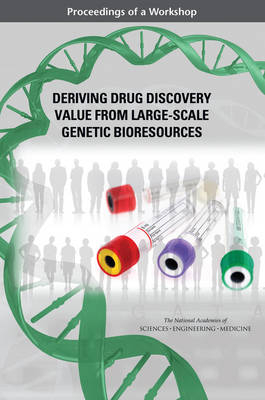
Deriving Drug Discovery Value from Large-Scale Genetic Bioresources
Proceedings of a Workshop
Seiten
2016
National Academies Press (Verlag)
978-0-309-44778-2 (ISBN)
National Academies Press (Verlag)
978-0-309-44778-2 (ISBN)
The process of discovering and developing a new drug or therapy is extremely costly and time consuming, and recently, it has been estimated that the creation of a new medicine costs on average more than $2 billion and takes 10 years to reach patients. The challenges associated with bringing new medicines to market have led many pharmaceutical companies to seek out innovative methods for streamlining their drug discovery research.
One way to increase the odds of success for compounds in the drug development pipeline is to adopt genetically guided strategies for drug discovery, and recognizing the potential benefits of collecting genetic and phenotypic information across specific populations, pharmaceutical companies have started collaborating with healthcare systems and private companies that have curated genetic bioresources, or large databases of genomic information. Large-scale cohort studies offer an effective way to collect and store information that can be used to assess gene–environment interactions, identify new potential drug targets, understand the role of certain genetic variants in the drug response, and further elucidate the underlying mechanisms of disease onset and progression.
To examine how genetic bioresources could be used to improve drug discovery and target validation, the National Academies of Sciences, Engineering, and Medicine hosted a workshop in March 2016. Participants at the workshop explored the current landscape of genomics-enabled drug discovery activities in industry, academia, and government; examined enabling partnerships and business models; and considered gaps and best practices for collecting population data for the purpose of improving the drug discovery process. This publication summarizes the presentations and discussions from the workshop.
Table of Contents
Front Matter
1 Introduction and Themes of the Workshop
2 Maximizing Discovery Capabilities Through Cohort Design
3 Discovery Activities Related to Genetic Bioresources
4 Business Models That Support Bioresource Discovery and Collaboration
5 Potential Next Steps in Using Genomics to Advance Drug Discovery
References
Appendix A: Workshop Agenda
Appendix B: Speaker Biographical Sketches
Appendix C: Statement of Task
Appendix D: Registered Attendees
One way to increase the odds of success for compounds in the drug development pipeline is to adopt genetically guided strategies for drug discovery, and recognizing the potential benefits of collecting genetic and phenotypic information across specific populations, pharmaceutical companies have started collaborating with healthcare systems and private companies that have curated genetic bioresources, or large databases of genomic information. Large-scale cohort studies offer an effective way to collect and store information that can be used to assess gene–environment interactions, identify new potential drug targets, understand the role of certain genetic variants in the drug response, and further elucidate the underlying mechanisms of disease onset and progression.
To examine how genetic bioresources could be used to improve drug discovery and target validation, the National Academies of Sciences, Engineering, and Medicine hosted a workshop in March 2016. Participants at the workshop explored the current landscape of genomics-enabled drug discovery activities in industry, academia, and government; examined enabling partnerships and business models; and considered gaps and best practices for collecting population data for the purpose of improving the drug discovery process. This publication summarizes the presentations and discussions from the workshop.
Table of Contents
Front Matter
1 Introduction and Themes of the Workshop
2 Maximizing Discovery Capabilities Through Cohort Design
3 Discovery Activities Related to Genetic Bioresources
4 Business Models That Support Bioresource Discovery and Collaboration
5 Potential Next Steps in Using Genomics to Advance Drug Discovery
References
Appendix A: Workshop Agenda
Appendix B: Speaker Biographical Sketches
Appendix C: Statement of Task
Appendix D: Registered Attendees
1 Front Matter; 2 1 Introduction and Themes of the Workshop; 3 2 Maximizing Discovery Capabilities Through Cohort Design; 4 3 Discovery Activities Related to Genetic Bioresources; 5 4 Business Models That Support Bioresource Discovery and Collaboration; 6 5 Potential Next Steps in Using Genomics to Advance Drug Discovery; 7 References; 8 Appendix A: Workshop Agenda; 9 Appendix B: Speaker Biographical Sketches; 10 Appendix C: Statement of Task; 11 Appendix D: Registered Attendees
| Erscheinungsdatum | 17.12.2016 |
|---|---|
| Verlagsort | Washington |
| Sprache | englisch |
| Maße | 152 x 229 mm |
| Themenwelt | Studium ► 2. Studienabschnitt (Klinik) ► Humangenetik |
| ISBN-10 | 0-309-44778-X / 030944778X |
| ISBN-13 | 978-0-309-44778-2 / 9780309447782 |
| Zustand | Neuware |
| Haben Sie eine Frage zum Produkt? |
Mehr entdecken
aus dem Bereich
aus dem Bereich
Eine sehr persönliche Geschichte | Der New York Times-Bestseller
Buch | Softcover (2023)
Ullstein Taschenbuch Verlag
CHF 30,75
Die revolutionäre Medizin von morgen (Lifespan)
Buch | Softcover (2020)
DuMont Buchverlag
CHF 22,40
Buch | Softcover (2022)
John Wiley & Sons Inc (Verlag)
CHF 169,95


